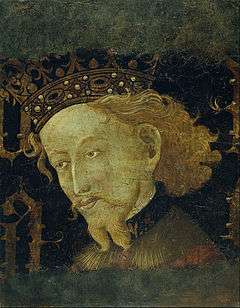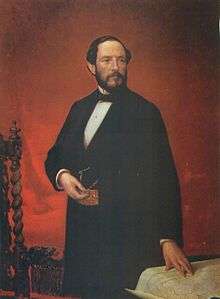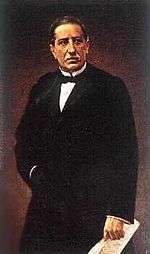History of Catalonia
| The Catalan / Valencian cultural domain |
|---|
 Catalan Constitutions, 1585 |
|
People |
|
Geo-political divisions |
The territory that now constitutes the autonomous community of Catalonia in Spain was first settled during the Middle Palaeolithic era. Like the rest of the Mediterranean side of the Iberian Peninsula, the area was occupied by the Iberians and several Greek and Carthaginian towns were established on the coast before the Roman conquest.
The area that is now Catalonia was the first area part of Hispania conquered by the Romans. It then came under Visigothic rule after collapse of the western part of the Roman Empire. In 718, the area was occupied by the Moors and became a part of Muslim ruled al-Andalus. The Frankish Empire conquered the area from the Muslims, beginning with the conquest of Roussillon in 760 and ending with the conquest of Barcelona in 801, as part of the creation of a larger buffer zone of Christian counties known as the Marca Hispanica.
In time, the counties of the region gave up their allegiance to the rulers of the Franks and their successors and became attached, as a self-governing principality under the Count of Barcelona, to the Crown of Aragon. The Principality of Catalonia became the main base for the Crown of Aragon's naval power and expansionism, that spread into Valencia, the Balearic Islands, and later into Sardinia, Sicily, Naples and, briefly, Athens. An identifiably Catalan culture developed in the later Middle Ages under the hegemony of the counts of Barcelona.
The marriage of Ferdinand II of Aragon and Isabella I of Castile in 1469 laid the foundations for a unified Crown of Spain. In 1492, the Emirate of Granada, the last political entity of al-Andalus in the peninsula, was conquered and the Spanish discovery and conquest of the Americas began. Political power began to shift away from the Crown of Aragon towards Castile.
For a considerable time, Catalonia retained its own laws as a principality of the Crown of Aragon but this came to an end when the new Bourbon dynasty secured the throne of Spain in the War of Spanish Succession (1701–1714) and made the former Crown of Aragon territories into provinces of the Crown of Castile following the war. During the war, Catalonia had supported the claim of a member of the Austrian branch of the Habsburg dynasty (after breaking an oath of loyalty to the French Bourbon prince Philip of Anjou (Philip V of Spain) from 1702). Following the surrender of Catalan troops on 11 September 1714, Philip V's enacted the Nueva Planta decrees banning all the main traditional Catalan political institutions and rights and merged its administration into that of the Crown of Castile as a province. However, the Bourbon monarchy allowed for Catalonia's civil law code to be maintained. With the exception of the loyal Basque Country, the new Bourbon king, Philip V of Spain, abolished the ancient privileges of all of Spain's medieval kingdoms, including the Crown of Aragon and with it, those of the Principality of Catalonia. Following the model of France, he imposed a unifying legislation and administration across Spain, as well as introducing the French Sallic Law and founding Spain's own Royal Academy in 1714. This led to the eclipse of Catalan as a language of government and literature. Economically, Catalonia experienced commercial growth in the late 18th century when the Bourbons ended Castile's trade monopoly with Spain's American colonies. The Napoleonic occupation and war in Spain in the early 19th century began a period of political and economic turmoil. In the latter half of the 19th century, Catalonia became a center of industrialization.
In the first third of the 20th century, Catalonia several times enjoyed and lost varying degrees of autonomy like other parts of Spain until the Second Spanish Republic confirmed the autonomies of Spain's traditional autonomous regions, including the autonomy of Catalonia and the official use of its language. Like Madrid, the Basque country and much of Spain, Catalonia fought hard to defend the Second Spanish Republic in the devastating civil war of 1936–1939. With the defeat of the Spanish Republic by the right wing forces of Francisco Franco, the autonomies were cancelled and regional languages like Catalan were made illegal. A great effort was made by Franco's regime to crush all regional cultures, languages and identities within Spain but without success. The Catalan language, like other regional languages, continued to be used in private.
In the years after the civil war life was difficult. With Spain devastated and cut off from international trade by boycotts, Catalonia, as a commercial and industrial center, suffered severely. The economic recovery was very slow and it was not until the mid-1950s that the economy reached the prewar levels of 1936. In 1959–1974 Spain experienced the second fastest economic expansion in the world in what became known as the Spanish Miracle and Catalonia prospered greatly from the expansion as Spain's most important industrial and tourist zone. In 1975 Franco died, bringing to an end his dictatorial regime, and in 1978 Catalonia voted overwhelmingly for the new democratic Spanish constitution that recognised Catalonia's autonomy and language.
Prehistory in Catalonia

The first known human settlements in what is now Catalonia were at the beginning of the Middle Palaeolithic. The oldest known trace of human occupation is a mandible found in Banyoles, described by some sources as pre-Neanderthal some 200,000 years old; other sources suggest it to be only about one third that old.[1] Some of the most important prehistoric remains were found in the caves of Mollet (Serinyà, Pla de l'Estany), the Cau del Duc in the Montgrí mountain ("cau" meaning "cave" or "lair"), the remains at Forn d'en Sugranyes (Reus) and the shelters Romaní and Agut (Capellades), while those of the Upper Paleolithic are found at Reclau Viver, the cave of Arbreda and la Bora Gran d'en Carreres, in Serinyà, or the Cau de les Goges, in Sant Julià de Ramis. From the next prehistoric era, the Epipaleolithic or Mesolithic, important remains survive, the greater part dated between 8000 BC and 5000 BC, such as those of Sant Gregori (Falset) and el Filador (Margalef de Montsant).
The Neolithic era began in Catalonia around 4500 BC, although the population was slower to develop fixed settlements than in other places, thanks to the abundance of woods, which allowed the continuation of a fundamentally hunter-gatherer culture. The most important Neolithic remains in Catalonia are the Cave of Fontmajor (l'Espluga de Francolí), The Cave of Toll (Morà), the caves Gran and Freda (Montserrat) and the shelters of Cogul and Ulldecona.
The Chalcolithic or Eneolithic period developed in Catalonia between 2500 and 1800 BC, with the beginning of the construction of copper objects. The Bronze Age occurred between 1800 and 700 BC. There are few remnants of this era, but there were some known settlements in the low Segre zone. The Bronze Age coincided with the arrival of the Indo-Europeans through the Urnfield Culture, whose successive waves of migration began around 1200 BC, and they were responsible for the creation of the first proto-urban settlements. Around the middle of the 7th century BC, the Iron Age arrived in Catalonia.
The rise of the Iberian culture
An iron using culture first appeared in eastern Iberia in the 8th century BC. By the 5th century BC, the Iron Age Iberian civilization had become consolidated on the eastern side of the Iberian Peninsula. What is now the Catalan territory was home to several distinct tribes of Iberians: the Indigetes in Empordà, the Ceretani in Cerdanya and the Airenosins in the Val d'Aran. At this time, the Greek trading city of Empúries (Emporion meaning market, then Emporiae), was founded on the coast by the Greek city of Phocaea in the 6th century BC.
Roman times
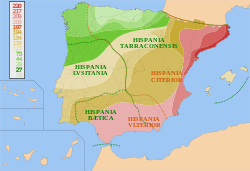
Romanization brought a second, distinct stage in the ancient history of Catalonia. Gnaeus Cornelius Scipio Calvus arrived in Empúries, with the objective of cutting off the sources of provisions of Hannibal's Carthaginian army during the Second Punic War. After the Carthaginian defeat, and the defeat of various Iberian tribes who rose up against Roman rule, 195 BC saw the effective completion of the Roman conquest of the territory that later became Catalonia and Romanization began in earnest. The various tribes were absorbed into a common Roman culture and lost their distinct characteristics, including differences of language.
Most of what is now Catalonia first became part of the Roman province of Hispania Citerior; after 27 BC, they became part of Tarraconensis, whose capital was Tarraco (now Tarragona). The arrival of Roman administrative and institutional structures led to the development of a network of cities and roads, the adoption of agriculture based on cereals, grapes, and olives, the introduction of irrigation, the development of Roman law, and the adoption of the Latin language.
From late antiquity to feudalism
Visigothic and Muslim rule
The Crisis of the Third Century affected the whole Roman Empire, and gravely affected the Catalan territory, where there is evidence of significant levels of destruction and abandonment of Roman villas. This is also the period of the first documentary evidence of the arrival of Christianity. While archaeological evidence shows the recovery of some urban nuclei, such as Barcino (later Barcelona), Tarraco (later Tarragona), and Gerunda (later Girona), the previous situation was not restored: the cities became smaller, and constructed defensive walls.
In the 5th century, as part of the invasion of the Roman Empire by Germanic tribes, the Visigoths led by Athaulf, installed themselves in the Tarraconensis (Ebro basin, 410) and when in 475 the Visigothic king Euric formed the kingdom of Tolosa (modern Toulouse), he incorporated the territory equivalent to present-day Catalonia. Later, the Visigothic kingdom lost most of its territory north of the Pyrenees and shifted its capital to Toledo. The Visigothic Kingdom of Hispania lasted until the early 8th century. In 714, the Umayyad forces reached the northeastern part of the peninsula, where some important clashes took place (Zaragoza, possibly Barcelona). In 720, Narbonne fell to the joint Arab-Berber forces, followed by the conquest of the remains of the Visigothic kingdom, Septimania (Nîmes captured in 725). The last Visigothic king Ardo died in the theatre of war (721).
Carolingian conquest

After repelling Muslim incursions as far north as Tours in 732, the expanding Frankish Empire set about creating a buffer zone of Christian counties in the south that became known at the Marca Hispanica or the Spanish March. The first county to be conquered from the Moors lied in the former area of Septimania that became Roussillon (with Vallespir), following the conquest of Narbonne (759). In 785 the County of Girona (with Besalú) on the south side of the Pyrenees was taken. Ribagorza and Pallars were linked to Toulouse and were added to this county around 790. Urgell and Cerdanya were added in 798. The first records of the county of Empúries (with Perelada) are from 812 but the county was probably under Frankish control before 800. After a series of struggles, Charlemagne's son Louis took Barcelona from the Moorish emir in 801 and set up the County of Barcelona.
The counts of the Marca Hispanica had small outlying territories, each ruled by a lesser miles with armed retainers, who owed allegiance through the Count to the Emperor, or to his Carolingian and Ottonian successors.
At the end of the 9th century, the Carolingian monarch Charles the Bald designated Wilfred the Hairy — a noble descendant of a family from Conflent and son of the earlier Count of Barcelona Sunifred I — as Count of Cerdanya and Urgell (870); after Charles's death (877), Wilfred became the Count of Barcelona and Girona (878) as well, which brought together the greater part of what was later to become the Catalan territory, and although on his death the counties were divided again among his sons, except for one brief period Barcelona, Girona, and Ausona continued to be unified under one count. As a result, Wilfred made its title hereditary and founded the dynasty of the House of Barcelona, which ruled Catalonia until 1410,
The rise and fall of the aloers
During the 10th century the Catalan counts became increasingly independent of the Carolingian rulers. Fealty broke down entirely when the count Borrell II made official in 987 when he failed to swear fealty to Hugh Capet, the first Capetian monarch of the emerging French kingdom. In those years, the population of the Catalan counties began to increase for the first time since the Muslim invasion. During the 9th and 10th centuries, the counties increasingly became a society of aloers, peasant proprietors of small, family-based farms, who lived by subsistence agriculture and owed no formal feudal allegiance.
The 11th century was characterized by the development of feudal society, as the miles formed links of vassalage over this previously independent peasantry. The middle years of the century were characterized by virulent class warfare. Seigniorial violence was unleashed against the peasants, utilizing new military tactics, based on contracting well armed mercenary soldiers mounted on horses. By the end of the century, most of the aloers had been converted into vassals.
This coincided with a weakening of the power of the counts and the division of the Spanish Marches into more numerous counties, which gradually became a feudal state based on complex fealties and dependencies. From the time of the triumph of Ramon Berenguer I over the other Catalan counts, the counts of Barcelona stood firmly as the link in a web of fealty between the Catalan counts and the Crown.
First references to the name Catalonia
The term "Catalonia" is first documented in an early 12th-century Latin chronicle called the Liber maiolichinus, where Ramon Berenguer III, Count of Barcelona is referred to as catalanicus heroes, rector catalanicus, and dux catalanensis.
Some manuscripts suggest that Catalunya (Latin Gathia Launia) Gothia (or Gauthia), "Land of the Goths", since the origins of the Catalan counts, lords and people were found in the ancient March of Gothia, known as Gothia, whence Gothland > Gothlandia > Gothalania from which Catalonia has been theoretically derived.[2][3] During the Middle Ages, Byzantine chroniclers claimed that Catalania derives from the local medley of Goths with Alans, initially constituting a Goth-Alania.[4] Alternatively, the name may come from the word "ca(s)telan" (habitant of the castle) as the area had many fortifications.
Besides, the names Catalonie or Cathalania (Catalonia) and catalanenses (Catalans) are easily found referring to a geographical area and its inhabitants related to the people of the Languedoc.
Catalonia, Aragon and Castile
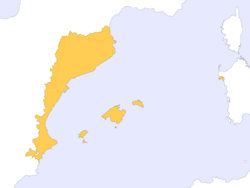
Dynastic union with Aragon
Until the middle of the 12th century, the successive counts of Barcelona tried to expand their domain in multiple directions. Ramon Berenguer III incorporated the County of Besalú, part of the County of Empúries, all of the County of Cerdanya, and also the County of Provence through his marriage to Douce of Provence. The Catalan church, for its part, became independent of the bishopric of Narbonne by restoring the archiepiscopal see of Tarragona (1118).
In 1137 the Crown of Aragon was created by the marriage of Queen Petronilla of Aragon and Ramon Berenguer IV, Count of Barcelona. Ramon Berenguer IV used the title "comes Barchinonensis" (count of the Barcelonans) as his primary title and "princeps Aragonensis" (prince of the Aragonians) as his second title, beside his wife who retained her title of Regina ("queen"). Their son and heir, Alfonso II of Aragon consolidated the dynastic union as Rex Aragonum, Comes Barchinone et Marchio Provincie ("king of Aragon, count of Barcelona, and marquis of Provence").[5] Catalonia and Aragon retained their distinct traditional rights, and Catalonia its own personality with one of the first parliaments in Europe, the Catalan Corts.
In addition, the reign of Ramon Berenguer IV saw the Catalan conquest of Lleida and Tortosa, completing the unification of all of the territory that comprises modern Catalonia. This included a territory to the south of the historic Spanish Marches, which became known as Catalunya Nova ("New Catalonia") and which was repopulated with Catalans by the end of the 12th century.
Expansion

Catalonia became the base for the Aragonese Crown's sea power, which came to dominate a maritime empire that extended across the western Mediterranean after the conquest of Valencia, the Balearic Islands, Sardinia, and the accession in Sicily of the kings of Aragon. This period saw a large increase of maritime trade in Catalan ports, particularly of the Aragonese Crown's leading city, Barcelona.
At the end of the 12th century, a series of pacts between the crowns of Aragon and Castile delimited the zones that the two would each attempt to conquer from Muslim-ruled kingdoms, (the "Reconquista"); to the east, in 1213, the defeat and death of Peter II of Aragon ("Peter the Catholic") in the Battle of Muret put an end to the project of consolidating the Aragonese influence and power over Provence. His successor James I of Aragon did not fully consolidate his power until 1227; once he consolidated his inherited realm, he began a series of new conquests. Over the course of the next quarter-century he conquered Majorca and Valencia.
The latter became a new state, the third kingdom associated with the Crown of Aragon, with its own court and a new fuero (code of laws): the Furs de Valencia. In contrast, the Majorcan territory together with that of the counties of Cerdanya, Vallespir, Capcir and Roussillon and the city of Montpellier were left as a kingdom for his son James II of Majorca as the Kingdom of Majorca. This division began a period of struggle that ended with the annexation of that kingdom by the Crown of Aragon in 1344 by Peter IV "the Ceremonious".
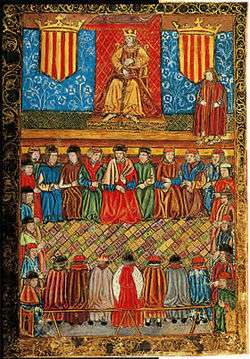
The Principality of Catalonia saw a prosperous period at the end of the 13th century and the beginning of the 14th. The population increased; Catalan culture expanded into the islands of the Western Mediterranean. The reign of Peter III of Aragon ("the Great") included the conquest of Sicily and the successful defense against a French crusade; his son and successor Alfonso ("the Generous") conquered Minorca; and Peter's second son James II, who first acceded to the throne of Sicily and then succeeded his older brother as king of Aragon, conquered Sardinia; under James II, and Catalonia was the center of the flourishing Aragonese empire.
At the same time, the Principality of Catalonia developed a complex institutional and political system based in the concept of a pact between the estates of the realm and the king. Laws had to be approved in the General Court of Catalonia, one of the first parliamentary bodies of Europe that banned the royal power to create legislation unilaterally, since 1283.[6] The Courts were composed of the three estates, were presided over by the king of Aragon, and approved the constitutions, which created a compilation of rights for the citizenship of the Principality. In order to collect general taxes, the Courts of 1359 established a permanent representation of deputies, called Deputation of the General (Catalan: Diputació del General) and later sometimes known as Generalitat, which gained an important political power in the next centuries.
The second quarter of the 14th century saw crucial changes for Catalonia, marked by a succession of natural catastrophes, demographic crises, stagnation and decline in the Catalan economy, and the rise of social tensions. The reign of Peter the Ceremonious was a time of war: the annexation of Majorca, the quelling of a rebellion in Sardinia, a rebellion by Aragonese unionists (that was, a faction who wished to extinguish local Catalan privileges in favor of a more centralized kingdom of Aragon), and an Aragonese-Castilian war. These wars created a delicate financial situation, in a framework of demographic and economic crisis, to which was added a generation later a crisis of succession generated by the death in 1410 of Martin I without a descendant or a named successor. A two-year interregnum progressively evolved in favor of a candidate from the Castilian Trastámara dynasty, Ferdinand of Antequera, who after the Compromise of Caspe (1412), was named Ferdinand I of Aragon.
Ferdinand's successor, Alfonso V ("the Magnanimous"), promoted a new stage of Aragonese expansion, this time over the Kingdom of Naples, over which he finally gained dominion in 1443. At the same time, though, he aggravated the social crisis in the Principality of Catalonia, both in the countryside and in the cities. The outcome of these conflicts was the 1462 "remença" (serfs') rebellion, a peasant rebellion against seignorial pressures, which led to a ten-year civil war that left the country exhausted. The remença conflict did not reach any definitive conclusion and from 1493 France formally annexed the counties of Roussillon and Cerdanya, which it had occupied during the conflict. Ferdinand II of Aragon ("Ferdinand the Catholic") finally resolved the major grievances of the remences with the Sentencia Arbitral de Guadalupe in 1486, profoundly reformed Catalan institutions, recovered without war the northern Catalan counties, and increased active involvement in Italy.
In 1481, the Catalan Courts aprroved the Constitució de l'Observança, which established the submission of royal power to the laws of the Principality of Catalonia.
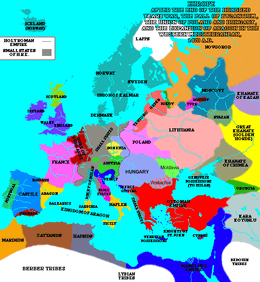
Crown of Aragon union with Crown of Castile
Ferdinand's 1469 marriage to Isabella I of Castile brought about a dynastic union of the Crown of Aragon with Castile. After the 1512 invasion of the Kingdom of Navarre, in 1516 the monarchies were formally united into a single Monarchy of Spain ("Kingdom of the Spains", as it was known). Each kingdom of the Monarchy conserved its political institutions and maintained its own courts, laws, public administration, and separate coinage of money.
When Christopher Columbus made his discovery in The Americas during a Spanish-sponsored expedition, and began to shift Europe's trade and economic centre of gravity (and the focus of Spain's ambitions) from the Mediterranean to the Atlantic Ocean, undermining Catalonia's economic and political importance. Aragonese and Catalan power in the Mediterranean would continue, but efforts to achieve further Spanish conquests in Europe itself largely stopped and the maritime expansion into the Atlantic and the conquest of territories in the Americas was not a Catalan enterprise. Castile and Aragon were separate states until 1716 in spite of a shared crown and the newly established colonies in the Americas and Pacific were Castilian, administered as appendages of Castile, until in 1778 Seville was the only port authorized to trade in America, and until the dynastic union Catalans, as subjects of the Crown of Aragon, had no right to trade directly with the Castilian-ruled Americas.
In the 16th century, the Catalan population began a demographic recovery and some measure of economic recuperation. The reign of Charles V, Holy Roman Emperor as Charles I of Spain was a relative harmonious period, during which Catalonia generally accepted the new structure of Spain, despite its own marginalization. As the focus of Spanish maritime power and of European rivalry shifted to the Atlantic, the Kingdom of Valencia became the most important kingdom of the former Aragonese confederation, eclipsing Barcelona. The reign of Philip II marked the beginning of a gradual process of stagnation of Catalan economy, language, and culture. Among the most negative elements of the period were a rise in piracy along the coasts and banditry in the interior.
The Reapers' War

The Reapers' War (Catalan: Guerra dels Segadors, 1640–52) started as an uprising of peasants in Barcelona. Conflicts had already arisen between Catalonia and the monarchy in the time of Philip II. Having exhausted the economic resources of Castile, Philip wished to avail himself of those of Catalonia; the Catalan governmental institutions and laws were well protected by the terms of union of the kingdoms, and were jealously guarded by the Catalan population, while the participation of the political community in the government of the Principality were increased. After Philip IV acceded to the throne in 1621, the Count-Duke of Olivares attempted to sustain an ambitious foreign policy by taxing the kingdoms of the Iberian Peninsula, which meant laying aside the until-then-prevailing principles of confederation, in favor of centralism (often referred to in a Spanish context as unitarism). Resistance in Catalonia was especially strong, given the lack of any significant apparent regional return for the sacrifices. The Catalan Courts of 1626 and 1632 were never concluded, due to the opposition of the estates against the economical and military mesures of Olivares, which violates the Catalan constitutions.

When Spanish tercios (military corps) concentrated in Roussillon at the end of the 1630s, because of the Thirty Years' War with France, the local peasants were required to lodge and provision the troops. On 7 June 1640 an uprising known as the Corpus de Sang took the lives of various royal functionaries, not all of them Castilian. Mutinies continued; few weeks later Pau Claris, president of the Generalitat of Catalonia, called the politician members from all the Principality in order to form a Junta de Braços or Braços Generals (General Estates), a consultive body. The calling was a success, and the presence of cities and feudal villages was exceptionally large. This assembly, which worked with individual voting, began to create and apply various revolutionary measures, such as the establishment of a Council of Defense of the Principality, a special tax for the nobility (the Batalló) and made contacts with the Kingdom of France, while the tension with the monarchy grew and started the military conflicts.
Finally, on 17 January 1641, the General Estates declared the Catalan Republic under the protection of France, but a week later the Catalan institutions, needing more French military aid, accepted the King Louis XIII of France as Count of Barcelona. This allowed the French army to cross the Pyrenees into the Iberian peninsula during the long Franco-Spanish War. After major setbacks, Spanish forces had driven out the French and crushed the rebellion by 1652 and most of Catalonia was once again part of the Monarchy of Spain, but Catalonia gained recognition of its rights from the Spanish Habsburg monarchy, with a few exceptions. When the war between Spain and France ended in 1659, the peace treaty ceded the Catalan-speaking territories north of the Pyrenees, Roussillon, Conflent, Vallespir, Capcir, and the northern half of Cerdanya, to France.
War of the Spanish Succession

In the last decades of the 17th century during the reign of Spain's last Habsburg king, Charles II, despite intermittent conflict between Spain and France, the Catalan economy recovered, not only in Barcelona, but also along the Catalan coast and even in some inland areas. However, at the end of the century, after the death of the childless Charles II (1700), the Crown of Spain went to his chosen successor, Philip V of the House of Bourbon. The Grand Alliance of Austria, England and the United Provinces gave military support to a Habsburg claimant of the crown, Archduke Charles. Catalonia initially accepted Philip V following prolonged negotiations between Philip V and the Catalan Corts between 12.10.1701 and 14.1.1702, which resulted in an agreement where the Principality of Catalonia retained all its previous privileges and gained a Court of Contraventions (Tribunal de Contrafaccions), the status of free port (Port Franc) for Barcelona as well as the right to commerce with America, but this did not last. In 1705 the Archduke entered Barcelona, which recognized him as King in 1706; thus breaking an oath of loyalty to the Bourbon claiment, which had negative repercussions for Catalonia when Philip V eventually won the war.
The resulting Spanish War of Succession (1705–14) may have benefitted Charles's foreign allies but was a disaster for the Catalans, Valencians and Aragonese. The Treaty of Utrecht (1713–14) ended the possibility of Barcelona's resistance to Bourbon rule, which it surrendered on 11 September 1714. The Bourbon king, determined to punish what he saw as sedition from Catalonia and Valencia established the Nueva Planta decree (1716), abolishing the Catalan constitutions and with it the Catalan and Valencian parliaments and rights and established a new territorial structure. He suppressed the Catalan universities (Barcelona University moved to Cervera) and abolished the administrative use of the Catalan language; half a century later, the Catalan language would also be banned from primary and secondary schools.
Economic recovery
Despite the difficult internal situation, Catalonia recovered significantly in the course of the 18th century. The population and the economy both grew, agricultural production increased, and trade increased (especially thanks to increased commerce with the Americas), transformations all of which (as in France) tended to undermine the Old Regime and lay the ground for the rise of industrialization, the first signs of which appeared in the 18th-century manufacture of cotton goods and other textiles. By the end of the 18th century, the popular classes began to experience the first effects of proletarianization.
The Napoleonic Wars
In the 1790s, new conflicts arose on the French border, due to the French Revolution and the French Revolutionary Wars. In 1808, during the Napoleonic Wars, Catalonia was occupied by the troops of General Guillaume Philibert Duhesme. The official Spanish army had evaporated, but popular resistance against the French occupation occurred in Catalonia as in other parts of Spain, and eventually developed into the Peninsular War. Girona was besieged by the French and defended by its inhabitants under the direction of general and military governor Mariano Álvarez de Castro. The French finally took the city on 10 December 1809, after many deaths on both sides from hunger, epidemics, and cold; Álvarez de Castro died in prison one month later. At the same time, Napoleon takes the direct control of Catalonia for establish the order, creating the Government of Catalonia under the rule of Marshall Augereau, and making Catalan briely an official language.
Between 1812 and 1813, Catalonia was directly annexed to France itself, and organized as four (later two) départements.
French dominion in parts of Catalonia lasted until 1814, when the British General Wellington signed the armistice by which the French left Barcelona and the other strongholds that they had managed to keep until the last.
The Carlist wars
The reign of Ferdinand VII (reigned 1808–33) saw several Catalan uprisings and after his death the conflict over the succession between the absolutist "Carlist" partisans of Infante Carlos and the liberal partisans of Isabella II led to the First Carlist War, which lasted until 1840 and was especially virulent in the Catalan territory. As with the Basques, many of the Catalans fought on the Carlist side, not because they supported absolute monarchy, but because they hoped that restoration of the Old Regime would mean restoration of their fueros and recovery of regional autonomy.
The victory of the liberals over the absolutists led to a "bourgeois revolution" during the reign of Isabella II. The reign of Isabella II was marked by corruption, administrative inefficiency, centralism, and political and social tensions. The liberals soon divided into "moderates" and "progressives", and in Catalonia a republican current began to develop; also, inevitably, Catalans generally favored a more federal Spain.
In September 1868, Spain's continuing economic crisis triggered the September Revolution or La Gloriosa, beginning the so-called Sexenio Revolucionario, the "six revolutionary years" (1868–1873). Among the most notable events of this period were the government of General Joan Prim and his assassination, the federalist revolt of 1869, the rise of Amadeo to the monarchy, the proclamation of the First Spanish Republic, the outbreak of the Third Carlist War and the spread of the ideas of the First International.
Industrialization
The second third of the 19th century saw a Catalan cultural renaissance, a cultural movement to recover Catalan language and culture after a long period of decay. This became politically important to Spain as a whole, because in the latter half of the 19th century, Catalonia became a centre of Spain's industrialization and Catalonia became the largest textile producer in the Mediterranean. Catalonia had to contend with a grave shortage of energy resources and the weakness of the domestic Spanish market. To encourage industrial expansion, Spain established protectionist policies which reduced foreign competition domestically. These policies benefitted the country's industrial regions, Catalonia and the Basque Country. As in much of Europe, the labouring class was molded into an industrial proletariat, living and working in often inhuman conditions.
Catalan nationalism and the workers movement

In 1874, a coup by General Martínez Campos in Sagunto led to a restoration of the Bourbon dynasty in the person of Alfonso XII. A period of political stability, of repression of the workers movement, and of a slow growth in Catalan nationalist identity extended to the early years of the 20th century, when once again political opposition broke to the fore, especially republicanism and Catalan nationalism, but also class-based politics reflecting social tensions.
The following decades saw the rise of the political Catalanism still prevalent today: the first formulations of the modern Catalan national identity can be seen in Valentí Almirall, a relevant federalist republican. In 1901 Enric Prat de la Riba and Francesc Cambó formed the Regionalist League, which led to the electoral coalition Solidaritat Catalana. Catalan nationalism, under the leadership of Prat de la Riba, achieved in 1913 a victory in obtaining partial self-government for the "Commonwealth" (Catalan: Mancomunitat; Spanish: Mancomunidad), a grouping of the four Catalan provinces, presided over first by Prat de la Riba, and later by Josep Puig i Cadafalch; this was later suppressed in March 1925, during the 1923–1930 dictatorship of Miguel Primo de Rivera. The Commonwealth of Catalonia established an important modern infraestructure (roads, telephones, Metro...) and expanded the culture (libraries, professional education, use and regulation of Catalan language, study of sciences...).
The Catalan workers movement at the turn of the twentieth century consisted of three tendencies: syndicalism, socialism, and anarchism, part of the last openly embracing "propaganda of the deed" as advocated by Alejandro Lerroux. Along with Asturias, Catalonia in general and Barcelona in particular was a center of radical labor agitation, marked by numerous general strikes, assassinations (especially in the late 1910s), and the rise of the anarchist Confederación Nacional del Trabajo (National Confederation of Labour, CNT). The Anarchists had been active throughout the early 20th century, achieving the first eight-hour workday in Europe in 1919. The escalating violence between Catalan workers and the Catalan bourgeoisie led the latter to embrace the dictatorship of Primo de Rivera, despite his centralizing tendencies. (See also Anarchism in Spain.). The initial acceptance of the dictatorship by the conservative Lliga made the Catalan nationalism progressively more leftist (with the rise of parties as Acció Catalana, Catalan Republican Party or the Socialist Union of Catalonia) and, some of them, also pro-independence (mainly Estat Català). Despite this tolerance, Primo de Rivera abolished the Commonwealth of Catalonia in 1925 and started a policy of repression against the Catalan republican nationalism, Catalan language and labour movement (specially anarchism and communism). In 1926, Estat Català tried to invade with a little army (established in the town of Prats de Molló, Roussillon), leaded by Francesc Macià, Catalonia from France and proclaim the independent Catalan Republic, but the complot was discovered by the French police. Macià and the Catalan situation gained popularity all over the world.
During the last steps of the dictatorship, Barcelona celebrated the 1929 Universal Exposition, while Spain started to suffer an economical crisis caused by the economical policy of the government and the Wall Street Crash.
Republic and civil war

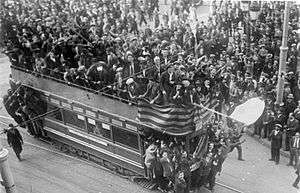
After the fall of Primo de Rivera, the Catalan left made great efforts to create a united front under the left-wing independentist leader, Francesc Macià, founder of Estat Català. The Esquerra Republicana de Catalunya (Republican Left of Catalonia, or ERC) represented a break with the electoral abstentionism that, until then had been characteristic of the Catalan workers. Advocating moderate socialism and Catalan self-determination, the party achieved a spectacular victory in the municipal elections of 12 April 1931, which preceded the 14 April proclamation of the Second Spanish Republic. After a brief proclamation of the Catalan Republic (14–17 April) by the ERC leader, Francesc Macià, the Generalitat of Catalonia was revived as an autonomous government, and a September 1932 statute of autonomy for Catalonia gave a strong, though not absolute, grant of self-government. A similar statute granted autonomy to the Basque Country, few years later.
Under its two presidents, Francesc Macià (1931–1933) and Lluís Companys (1934–1939), the republican Generalitat, under the democratic control of the left, carried out a considerable task in different areas such as culture, health, education and civil right, despite the serious economic crisis, its social repercussions and the political vicissitudes of the period, including its suspension in 1934, due to an uprising in Barcelona in October that year, in which the president Companys proclaimed the Catalan State of the Spanish Federal Republic, quickly suppressed by the Spanish army, and Catalan Government remained arrested. As for the workers' movement, there was the CNT crisis with the break-away faction in the 1930s and the formation of the Workers' Party of Marxist Unification (Spanish: Partido Obrero de Unificación Marxista, POUM) and Unified Socialist Party of Catalonia (Catalan: Partit Socialista Unificat de Catalunya, PSUC).
After the electoral victory of the left in the Spanish national elections of February 1936, and the subsequent restoration of the government of the Generalitat, came the July 1936 armed insurrection that led to the Spanish Civil War. The defeat of the initial military rebellion in Catalonia placed Catalonia firmly in the Republican camp. During the war, there were two rival powers in Catalonia: the de jure power of the Generalitat and the de facto power of the armed popular militias. Violent confrontations between the workers' parties culminated in the defeat of the CNT-FAI and POUM, against whom the PSUC unleashed strong repression. The local situation resolved itself progressively in favor of the Generalitat, but at the same time the Generalitat was partially losing its autonomous power within republican Spain.

The military forces of the Generalitat, partially organized between December 1936 and May 1937 in the People's Army of Catalonia (Exèrcit Popular de Catalunya), were concentrated on two fronts: Aragon and Majorca. The latter was an utter disaster. The Aragon front resisted firmly until 1938, when the occupation of Lleida and Balaguer destabilized it. Finally, Franco's troops broke the republican territory in two by occupying Vinaròs, isolating Catalonia from the rest of republican Spain. The defeat of the Republican armies in the Battle of the Ebro led in 1938 and 1939 to the occupation of Catalonia by Franco's forces, who abolished completely the Catalan autonomy and brought in a dictatorial regime, which took strong measures against Catalan nationalism and culture. Only forty years later, after Franco's death (1975) and the adoption of a democratic constitution in Spain (1978), did Catalonia recover its autonomy and reconstitute the Generalitat (1977).
George Orwell served with the POUM in Catalonia from December 1936 until June 1937. His memoir of that time, Homage to Catalonia, was first published in 1938 and foreshadowed the causes of Second World War. It remains one of the most widely read books on the Spanish Civil War.
Franco's dictatorship
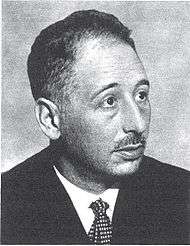
As in the rest of Spain, the Franco era (1939–1975) in Catalonia saw the annulment of democratic liberties, the prohibition and persecution of parties, the rise of thoroughgoing censorship, and the banning of all leftist institutions. In Catalonia it also meant, yet again, the repression of Catalan culture, the annulment of the Statute of Autonomy, the banning of the whole specifically Catalan institutions, and the complete suppression of the Catalan-language press, although a limited publication of Catalan books was allowed from 1943. During the first years, all resistance was energetically suppressed, the prisons filled up with political prisoners, and thousands of Catalans went into exile. In addition, 4000 Catalans were executed between 1938 and 1953, among them the former president of the Generalitat Lluís Companys.
After an initial period in which Spain tried to build an autarky, Franco's regime changed its economic policies and in the 1960s and early 1970s the economy entered a period of rapid economic expansion that became known as the Spanish Miracle. The period was marked by agricultural modernization, a massive expansion of industry and the start of mass tourism. As industry in Catalonia expanded, workers migrated from rural areas across Spain to work in Barcelona and its surrounding area, turning it into one of Europe's largest industrial metropolitan areas. Working-class opposition to Franco began to appear, usually clandestinely, and most notably in the form of the Comisiones Obreras ("Workers Commissions"), a return of trade union organizing, and the revival of the PSUC. In the 1970s democratic forces united under the banner of the Assemblea de Catalunya ("Catalan Assembly").
Democracy restored

Franco's death initiated a period that came to be known as the "democratic transition", during which democratic liberties were restored, culminating in the Spanish Constitution of 1978. This constitution recognized the existence of multiple national communities within the Spanish State, which proposed the division of the country into autonomous communities. The first general elections in 1977 restored a provisional Generalitat, headed by its president in exile Josep Tarradellas, and including representatives of the various leading forces of the time. In 1979, the new Statute of Autonomy was finally approved delegating more autonomy in matters of education and culture than the republican 1932 Statute, but less in terms of the systems of justice and public order. In it, Catalonia is defined as a "nationality", Catalan is recognized as Catalonia's own language, and became co-official with Spanish. New elections to the Parliament of Catalonia under this Statute gave the Catalan presidency to Jordi Pujol, a position he would hold until 2003. During this time he also led Convergència i Unió (Convergence and Unity, CiU) a center-right Catalan nationalist electoral coalition consisting of his own Convergència Democràtica de Catalunya (Democratic Convergence of Catalonia, CDC) and the smaller and more conservative Unió Democràtica de Catalunya (Democratic Union of Catalonia).
Throughout the 1980s and 1990s the institutions of Catalan autonomy continued to develop, among them an autonomous police force (called Mossos d'Esquadra), the creation of the comarcal administrations (roughly equivalent to United States "counties" or United Kingdom "shires" or "counties", but distinct from the historical Catalan counties) and a High Court in the form of the High Court of Justice of Catalonia (Catalan: Tribunal Superior de Justícia de Catalunya).
Catalonia's Law of Linguistic Normalization promoted Catalan-language media. The Catalan government provides subsidies to various means of promoting Catalan culture, including (for example) the making of Catalan-language films or the subtitling of foreign-language films in Catalan.
In 1992 Barcelona hosted the Summer Olympics, which brought international attention to Catalonia. During the 1990s, the absence of absolute majorities in the Spanish parliament made governments reliant on support from the various nationalist parties (Catalan, Basque, Canary Islands, etc.) which was leveraged by CiU, to gain broaden the scope of Catalan autonomy during the last government of Felipe González (1993–1996) and the first of José María Aznar (1996–2000).
In November 2003, elections to the Generalitat gave the plurality, but not the majority of seats to CiU. Three other parties (Socialists' Party of Catalonia–Spanish Socialist Workers' Party, PSC-PSOE, Republican Left of Catalonia (ERC) and Initiative for Catalonia Greens (ICV)) united to take the government into a left-wing nationalist coalition, making Pasqual Maragall, (PSC-PSOE) the new president of Catalonia.
This government proved unstable, especially on the issue of reforming the Statute of Autonomy of Catalonia, and new elections were held in autumn 2006. The result was again a plurality, but not a majority, for CiU, and PSC-PSOE, ERC and ICV again formed a coalition.
On 16 September 2005, the ICANN officially approved the domain.cat, the first domain for a language community.
Independence process
The new Statute of Autonomy of Catalonia, approved after a referendum, was contested by important sectors of the Spanish nationalism and the conservative Popular Party, sending the law to the Constitutional Court of Spain which, in 2010, decided to declare non valid some of the articles that established an autonomous Catalan system of Justice, better aspects of the financing, the status of the Catalan language or the references of Catalonia as a nation. As a response, on 10 July 2010, it was organized a successful demonstration, and the civil society started a process of organization in order to win the right of self-determination. During the National Day of Catalonia, on 11 September 2012, a massive demonstration in the streets of Barcelona organized by the organization called Catalan National Assembly (Assemblea Nacional Catalana, ANC) claims for the independence and a referendum.
On 23 January 2013, parliament approved a Declaration on the Sovereignty and right to decide of the people of Catalonia asserting that Catalonia is a sovereign entity and calls for a referendum on independence.[7][8] After the impediments of Spanish institutions, on 9 November 2014 the Government of Catalonia organized the independence referendum, in which 80.8% of the cast votes supported the independence option.[9][10]
On 9 November 2015, parliament approved a Declaration to start the independence process of Catalonia asserting the start of the process to create an independent Catalan state in the form of a republic.[11][12][13][14]
Notes
- ↑ Grun, R; et al. (2005), "ESR and U-series analyses of enamel and dentine fragments of the Banyoles mandible", Journal of Human Evolution, doi:10.1016/j.jhevol.2005.10.001, retrieved 31 October 2006.
- ↑ Maximiano García Venero (2006-07-07). Historia del nacionalismo catalán: 2a edición. Ed. Nacional. Retrieved 2010-04-25.
- ↑ Ulick Ralph Burke (1900). A history of Spain from the earliest times to the death of Ferdinand the Catholic. Longmans, Green, and co. p. 154.
- ↑ The Sarmatians: 600 BC-AD 450 (Men-at-Arms) by Richard Brzezinski and Gerry Embleton, Aug 19, 2002.
- ↑ E. Bagué, J. Cabestany & P. Schramm, Els Primers Comtes-Reis, Vicens-Vives, 3rd. Edition, Barcelona, 1985, pp. 15–77.
- ↑ "Las Cortes Catalanas y la primera Generalidad medieval (s. XIII-XIV)". Retrieved 21 January 2013.
- ↑ "Catalonia declares itself a sovereign entity". Associated Press. Retrieved 23 January 2013.
- ↑ "The Catalan Parliament approves the 'Declaration of sovereignty and the right to self-determination by the people of Catalonia'". Catalan News Agency. 23 January 2013. Retrieved 10 November 2015.
- ↑ "2.25 million Catalans participate in non-binding vote, independence option won with 80% support". Catalan News Agency. 10 November 2014. Retrieved 10 November 2015.
- ↑ "Catalonia independence: 80% vote to split from Spain". The Independent. 10 November 2014. Retrieved 10 November 2015.
- ↑ "The Parliament declares the start of the independence process". Catalan News Agency. 9 November 2015. Retrieved 10 November 2015.
- ↑ "Catalonia launches process of separation from Spain". VilaWeb. 9 November 2015. Retrieved 10 November 2015.
- ↑ "Catalonia's parliament votes to begin setting up an independent state". The Telegraph. 9 November 2015. Retrieved 10 November 2015.
- ↑ "In Catalonia, the Independence Process Begins". Stratfor. 9 November 2015. Retrieved 10 November 2015.
References
- Historia de Cataluña, by V. Balaguer (II vols., Madrid, 1886, &c.)
- Historia de Cataluña, by A. Bori y Fontesta (Barcelona, 1898)
- Orígines históricos de Cataluña, by J. Balari y Jovany, Establecimiento Tipográfico de Hijos de Jaime Jesús, (Barcelona, 1899)
- Colecció de monografies de Catalunya, by J. Reig y Vilardell (Barcelona, 1
- Mentiras Historicas comunmente creidas by Jose Luis Vila-San-Juan Ed Planeta pp 215–230 1996 ISBN 84-08-01795-0
- This article draws on material in the corresponding article in the Spanish-language Wikipedia.
External links
| Wikimedia Commons has media related to History of Catalonia. |
- History of Catalonia
- Museum of the History of Catalonia
- The Spirit of Catalonia. 1946 book by Oxford Professor Dr. Josep Trueta
- The Spanish March at Convergence
- Videos of the "Jornades d'Història i Censura", 2011, Barcelona
